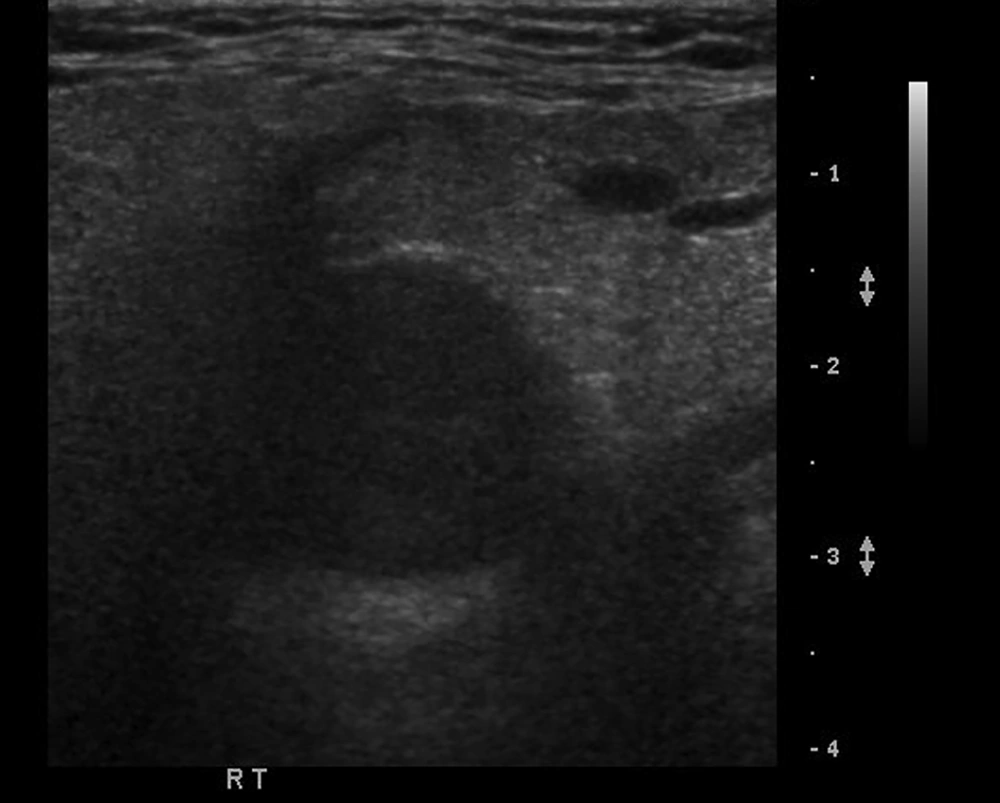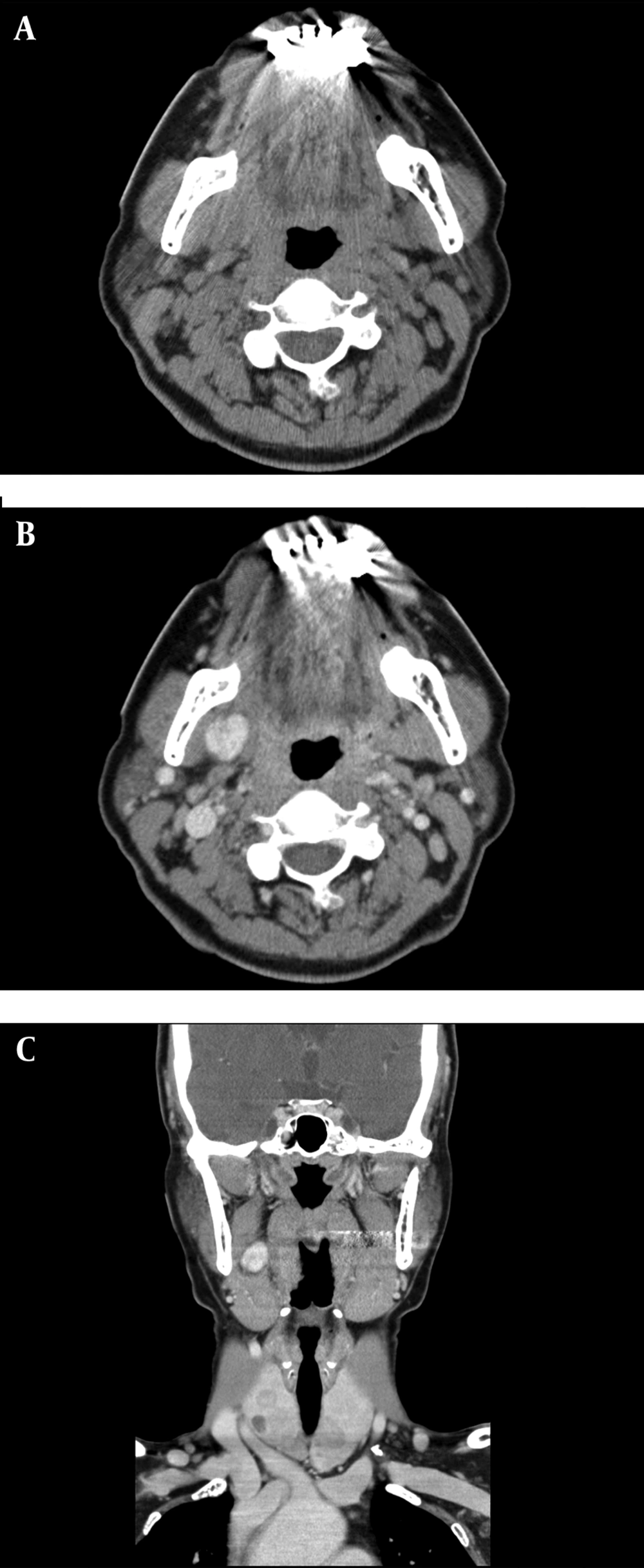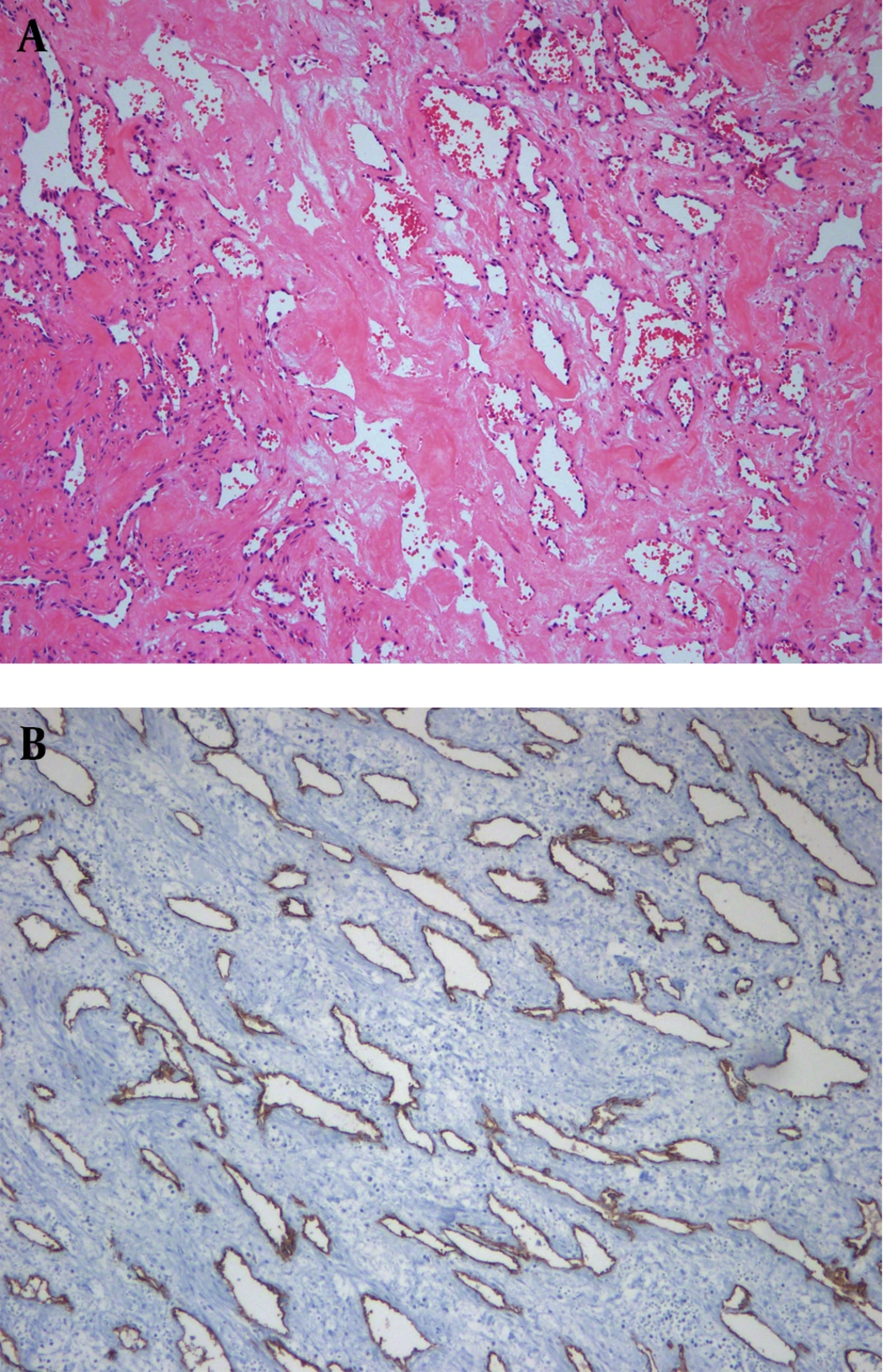1. Introduction
Nasopharyngeal angiofibromas are relatively rare tumors that represent 0.5% of all head and neck neoplasms and they predominantly occur in adolescent males (1). This type of tumor originates from the region of the sphenopalatine foramen. In most cases, imaging studies will demonstrate a widening of the pterygopalatine fossa and anterior bowing of the posterior wall of the maxillary sinus (2). The occurrence of extra-nasopharyngeal angiofibroma is very rare (1). I describe an extra-nasopharyngeal angiofibroma arising from the parapharyngeal space in a middle-aged woman without involvement of the sphenopalatine foramen or the nasopharynx. The patient underwent surgery and no recurrence developed.
2. Case Presentation
A 53-year-old woman presented with a diffuse anterior neck swelling of one-month duration. The patient had not undergone any previous surgery. Physical examination revealed no evidence of palpable cervical lymphadenopathy. Ultrasonography (US) showed diffuse goiter with multiple thyroid nodules. A homogeneous and hypoechoic solid mass, adjacent to the upper margin of the right submandibular gland with focal flow signals on color Doppler sonography within the mass was detected (Figure 1). A computed tomography (CT) scan revealed a circumscribed mass, hypodense to the masseter muscle and hyperdense to the parotid gland in the right parapharyngeal space (Figure 2 A-C). After intravenous contrast administration, the mass, 1.7 × 1.7 × 1.6 cm in size, demonstrated homogeneous enhancement without infiltration to the adjacent muscle. At that time, radiological differential diagnoses included salivary gland origin tumor or paraganglioma or neurogenic tumors. Enlargement of the bilateral thyroid lobes with multiple non-enhancing hypodense and calcified thyroid nodules was also noted. Under general anesthesia, this mass was excised surgically. The histological diagnosis was an angiofibroma without evidence of malignancy (Figure 3). After surgery, the patient revealed an uneventful postoperative course. At the three-year follow-up examination, the patient remained free of any recurrence.
3. Discussion
Angiofibromas are histologically benign, but potentially locally destructive fibro-vascular tumors that account for less than 0.5% of all head and neck neoplasms (3). They are usually found in young adolescent males (3). They originate from the region of the sphenopalatine foramen and commonly spread to the sphenoid sinus, the nasal cavity, and the pterygopalatine foramen (1). Angiofibromas that do not originate from the area around the sphenopalatine region are very rare (1). The primary site of extra-nasopharyngeal angiofibromas varies and can include the ethmoid and sphenoid sinuses, the nasal septum, the tonsils, the ears, the trachea, the larynx, and the infratemporal fossa (1). The most common site of extra-nasopharyngeal angiofiroma is the maxillary sinus. In the recent literature, only 75 cases have been reported including their case series (4). There were five more cases of extra-nasopharyngeal angiofibromas reported in the literature since then (5-9). Only one parapharyngeal angiofibroma was reported in a 25-year-old male in the English literature (10). They reported homogeneous enhancement on CT and hypervascularity on conventional angiogram in the left parapharyngeal mass. I report a similar contrast enhancement pattern on CT in this case report. However, conventional angiography was not performed. In the present case, I report the very rare case of an extra-nasopharyngeal angiofibroma arising from the right parapharyngeal space in a middle-aged woman. To the best of our knowledge, this represents the second demonstrated case of an angiofibroma originating in such a location. Extra-nasopharyngeal angiofibromas occur more commonly in females and tend to develop at an older age (11). The male-to-female ratio is roughly 3:1 and the mean age at presentation is 22 years. It is not well known why this discrepancy exists (1). The tumor I present here developed in a 53-year-old woman. Clinical manifestations of extra-nasopharyngeal angiofibromas are variable including headache, hoarseness, dysphagia, dyspnea, stridor, and pain according to their location (4, 11). Extra-nasopharyngeal angiofibromas may have less specific and confusing clinical symptoms and diagnosis may be delayed (4). Enlargement of the sphenopalatine foramen with an intensely enhancing mass is the typical pathognomonic radiological finding, especially in young boys (1). In the patient with characteristic radiological findings and typical clinical symptoms of nasopharyngeal angiofibromas, preoperative biopsy is not recommended due to hemorrhage (4). Extra-nasopharyngeal angiofibromas are harder to diagnose radiologically due to their various locations (4). Unlike nasopharyngeal angiofibromas, lack of hypervascularity on conventional angiograms does not exclude the diagnosis of extra-nasopharyngeal angiofibromas (2). The present case was detected incidentally. For the metastasis evaluation from thyroid cancer, a CT scan was performed. An axial CT showed well enhancing mass in the right parapharyngeal space without perilesional infiltration. The mass was thought to be a minor salivary gland origin tumor or a paraganglioma, hemangiopericytoma, solitary fibrous tumor or neurogenic tumor, preoperatively. Differential diagnoses of parapharyngeal masses may also include parapharyngeal space metastatic lymph node, lymphoma, inflammatory pseudotumor, tuberculous and fungal infections (12). The most acceptable treatment for angiofibroma is endovascular embolization and then surgical excision (13). Radiotherapy may be applied for unresectable cases (4). Nasopharyngeal angiofibroma seems to have a poorer prognosis than an extra-nasopharyngeal lesion due to inadequate surgical exposure; consequently, it may result in a higher recurrence rate (3). In the present case, complete surgical resection was performed without preoperative embolization. On follow-up after a period of 3 years, there was no tumor recurrence.


